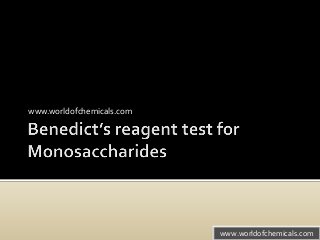
Benedict’s reagent test for monosaccharides
- 2. A reducing sugar is any sugar that is capable of acting as a reducing agent because it has a free aldehyde group or a free ketone group. Reducing sugars react with amino acids in the Maillard reaction, a series of reactions that occurs while cooking food at high temperatures and that is important in determining the flavour of food. Not all disaccharides will get positive results with this test. There are certain limitations for the disaccharides to give positive results. Benedict's reagent test can be used to test for the presence of glucose in urine, but this test is not recommended or used for the diagnosis of diabetes mellitus. www.worldofchemicals.com
- 3. The principle of Benedict's test is that when reducing sugars are heated in the presence of an alkali they get converted to powerful reducing species known as enediols. When Benedict’s reagent solution and reducing sugars are heated together, the solution changes its colour to orange-red/ brick red.This colour is due to the presence of simple carbohydrates. In specific, the copper (II) ions in Benedict’s solution are reduced to Copper (I) ions, which causes the colour change. www.worldofchemicals.com
- 4. It is an equal-volume mixture of aqueous solution of Copper Sulfate(CuSO4) and sodium citrate. Here sodium citrate is the complexing agent. Benedict's solution is a deep-blue alkaline solution used to test for the presence of the aldehyde functional group- CHO. Formation of red coloured copper(I) oxide indicates the formation of a precipitate.This precipitate is insoluble in water. As Benedict’s test continues, the concentration of reducing sugar increases. Following this condition, high amount of brick-red colour precipitate will be formed at the end of the test tube. Sometimes you will find small amounts of copper oxide along with brick-red precipitate. www.worldofchemicals.com
- 5. Sodium carbonate of Benedict’s reagent facilitates the alkaline conditions which are required for the redox reaction. Another compound Sodium citrate complexes with the copper (II) ions to avoid degradation into copper(I) ions during storage. Some complex type of carbohydrates like starch or amylum consisting of a large number of glucose monomer units joined by glycosidic bonds.Starch or amylum don’t react or react very poorly with Benedict's reagent, due to the relatively small number of reducing sugar units. Inositol is another complex carbohydrate which produces a negative result with Benedict’s test. www.worldofchemicals.com
- 6. Sucrose which is commonly known as table sugar contains two reducing sugars moieties fructose and glucose.These reducing sugar are joined by their glycosidic bond in such a way as to prevent the glucose isomerising to aldehyde, or the fructose to alpha-hydroxy-ketone form. Sucrose is thus a non-reducing sugar which does not react with Benedict's reagent. Sucrose still indirectly can produce a positive result with Benedict's reagent if heated with dilute hydrochloric acid(HCl) prior to the test.The acidic conditions and heat break the glycosidic bond in sucrose through hydrolysis process.The products of hydrolysis process are reducing sugars (glucose and fructose) which can be detected by Benedict's reagent. www.worldofchemicals.com
- 7. ThankYou To read this article follow the link: https://goo.gl/Mik27V www.worldofchemicals.com
